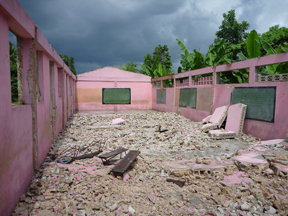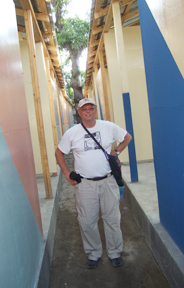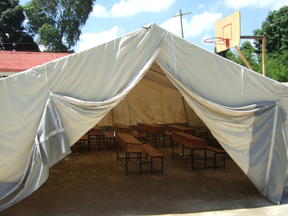Helping Haiti

LEOGANE, Haiti — William DeJong, co-founder of Schools for the Children of the World, recalls broken cityscapes and rubble-choked communities where only the barest signs of rebuilding was visible and temporary living tents were everywhere during his latest trip to Haiti.
It was on his fourth and most recent visit to the country back in June when DeJong started to see the beginnings of what he calls “a temporary or transitional phase” of development. New infrastructure was slowly taking shape and portions of the rubble, remnants of the January 12 earthquake that nearly destroyed Haiti, had been moved.
“When I first went there after the earthquake, I thought I saw about 100,000 tents,” says DeJong, in a telephone interview. “The second time I was there, I realized I was wrong: it was 200,000 tents. And more recently, I have been corrected – it’s more like 300,000 tents.”
Three organizations — SCW, the Council of Educational Facility Planners International, and the National Council of Structural Engineers  Association — are in the process of developing 16 new schools to replace a few of the more than 4,000 schools that were damaged or destroyed in January’s 7.3-magnitude quake. Currently in the design phase, the schools will provide an academic home to some of the approximately one million students whose schools were displaced by the earthquake, DeJong says. The Spanish Red Cross will fund the projects, which range from $300,000 to $2 million.
Association — are in the process of developing 16 new schools to replace a few of the more than 4,000 schools that were damaged or destroyed in January’s 7.3-magnitude quake. Currently in the design phase, the schools will provide an academic home to some of the approximately one million students whose schools were displaced by the earthquake, DeJong says. The Spanish Red Cross will fund the projects, which range from $300,000 to $2 million.
New construction is slow in Haiti as aid organizations and Haitians are focusing first on building transitional facilities around the destroyed structures.
“A lot of the rubble is starting to get moved,” DeJong says. “I can’t tell you how much of the rubble is getting moved by hand. Many times, re-construction crews will take a hundred Haitians, put them in yellow shirts, supply them with hammers and picks, and send them to a rubble pile. By the end of the day they’ll have gone through and completely removed the rubble off that site.”
In the days following the earthquake, DeJong and his colleagues began searching the Internet for news on what was happening in the way of redevelopment, assessing what was needed and where it was needed most. Having financed and built new schools in poorer communities in Central America, South America and Africa, DeJong said his colleagues at SCW, and their counterparts at CEFPI, and NCSEA, saw Haiti as their next target for relief aid.
“For the last three months, we have been working with Haiti’s government leaders to determine what’s needed nationwide, such as the creation of a new school building authority,” DeJong says. “We started taking a look at what might be done with the school facilities, as far as new systems that could be put into the place. So far, we have basically drafted out a concept for a new school building authority that would attempt to build 3,000 schools in the next four to five years.”
To create such a plan, DeJong and his colleagues have worked closely with the Haitian Ministry of Education, the Inter-American Development Bank, the Haitian president’s office, and Haiti’s Presidential Commission on Education.
DeJong is also collaborating with the Paul Vallas, the superintendent of New Orleans Recovery School District, who was personally invited by Haiti’s first lady, Elisabeth Preval, to assess the country’s educational system.
The need for a new public school system in Haiti is nearly as great as the need for school buildings there, DeJong explained. The majority of Haiti’s approximately 15,000 schools are private institutions run by independent operators. Many of the private schools grew out of a lack of public academic facilities — a situation that was created due to Haitian economic conditions. DeJong describes the condition of the Haiti’s K-12 academic buildings as being “inadequate, and in very poor condition,” even before the earthquake struck.
“There are basically no standards, no guidelines, and no codes in place for new construction,” he says. “A lot of the private operators would simply take over a storefront or convert a house into a school and start charging tuition. And tuition, which may only be $100 or $200 per year, does not seem like a lot of money. But when you are only making $600 or $700 per year, it is a lot of money.”
In April, DeJong and several architects and planners began traveling to Leogane, a port city located about 18 miles west of Port-au-Prince. There, they performed site assessments, established a partnership with the Spanish Red Cross and began developing school sites. Of the 66 pre-earthquake schools they visited in the region, DeJong says only three were standing.
“There are a lot of other organizations in Haiti, including Save the Children and UNICEF, that are developing temporary schools out of tent materials or plywood,” DeJong says. “What we are focusing on is building permanent facilities. We hope to start construction by August or September on the first series of these projects.”

Classrooms set up in tents have been the status quo in Haiti since the Jan. 12 earthquake.
Several design firms across the United States are volunteering their time to develop the schools, which will be built by the Spanish Red Cross and Haitian construction firms.
Chuck Newman, co-founder of SCW, and CEO of the Naperville, Ill.,-based Newman Architecture, is leading an oversight group for the Haitian school construction project. Once the partner firms complete their designs, Newman, DeJong, and others will take over and finish the construction documents.
“The firms’ responsibilities are to meet with each community, listen to what their needs are, [and] develop a schematic plan in partnership with the Spanish Red Cross,” says Newman. “The Spanish Red Cross will be responsible for physically building the schools and establishing agreements with the contractors, and such.”
With hurricane season already upon the Caribbean nation, the immediate need for permanent schools in Haiti is even greater, Newman says.
Many of the temporary schools [and] structures that are already overcrowded with students are going up on the sites where the permanent schools need to go. Tearing them down to build new ones could hit a soft spot in many Haitians’ hearts as the first signs of progress start to appear, he says.
“There’s a great need for schools because so many of them in Leogane, maybe 80 percent of the schools there, are not habitable without major repairs,” Newman explained. “One of our objectives is to [construct] new buildings as quickly as we can so they don’t develop temporary structures on the sites. Plus, these temporary structures are not really intended to be hurricane resistant.”
Burt Hill Architects is just one of the architectural firms donating time to design new schools. The Pittsburgh-based BRA is creating a replacement for the Sainte Rose de Lima public school, which has a roster of approximately 1,100 students.
In June, BRA principal Rob Pillar and his staff visited the site in Leogane where the $1 million school will be built. When completed, the building will house 12 classrooms for first through sixth grades, eight rooms for grades seven through twelve, two science laboratories, a library, administration offices, and residences for the educators. The approximately 20,000-square-foot school will be arranged in back-to-back classroom building pods, with open walls on one side of each classroom, roof overhangs that provide shade, and naturally ventilated areas. All of the onsite buildings will stand about three feet off the ground, as the area is a natural floodplain.
“We hope to start construction in October, and we plan to go back to the site during construction, and again once the school is complete,” says Pillar, adding that the project was not just about the firm building a replacement school.
“We want to develop a relationship with the school caretakers and staff to help them create a future-focused sustainable educational system,” Pillar says.
BRA is currently looking for an educational nonprofit or company that will sponsor Sainte Rose on an ongoing basis.
DeJong says that compared to schools SCW has built in nearby Honduras, school construction costs are nearly twice as much in Haiti, largely due the high cost of materials. For a Haitian school with 400 students, it could cost more than $500,000 to build, he says.
“These projects range from $500,000 to a couple million dollars each,” DeJong says. “Each one is a fairly significant project when you think about a third-world country.”
DeJong says he expects many of the schools to be similar in design to projects SCW has done in Honduras — simple structures made of block concrete with no air conditioning or heating. Most of the schools planned for Haiti will go up within a year to 18 months, with more projects likely to be added as SCW and the other organizations continue development.
“For all practical purposes, I’m on sabbatical from my regular job as this has just become all consuming,” says DeJong, who is founder and senior advisor at the DeJong-Richter educational facility consultancy firm. “I get up at about 6 a.m. in the morning and I think about those people in Haiti who are living in tents and I think we have to get this moving, we have to keep going.”
Finding volunteers and financiers has not been a problem thus far, says DeJong, who has received positive response from the private and nonprofit industries worldwide, as well as governments, all wanting to pitch in.
“Just today, for instance, I received two calls,” DeJong says “One was from a bank in [the Republic of] Trinidad and Tobago that wants to donate a school, and the other from the Finnish Government, which wants to donate $5 million worth of schools.”
